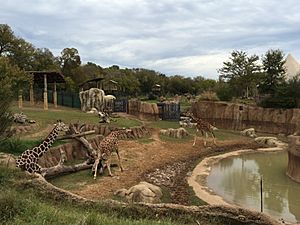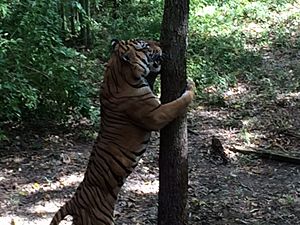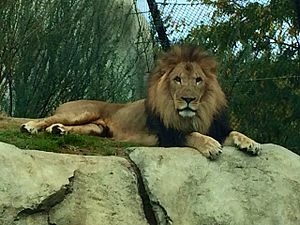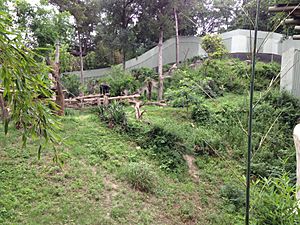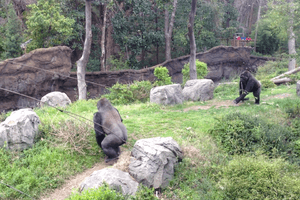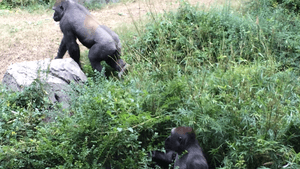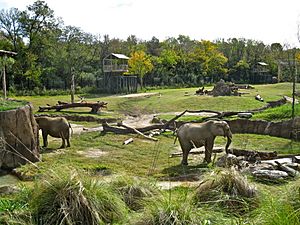Dallas Zoo facts for kids

Entrance to the Dallas Zoo
|
|
| Date opened | 1888 |
|---|---|
| Location | Dallas, Texas, U.S. |
| Land area | 106 acres (43 ha) |
| Coordinates | 32°44′24″N 96°48′54″W / 32.74000°N 96.81500°W |
| No. of animals | 2,000+ |
| No. of species | 406 |
| Annual visitors | 1+ million |
| Memberships | AZA, WAZA |
| Major exhibits | Gorilla Research Center, Endangered Tiger Habitat, Chimpanzee Forest, Simmons Hippo Outpost, Penguin Cove, Giants of the Savanna |
The Dallas Zoo is a huge animal park located about 3 miles south of downtown Dallas, Texas. It covers 106 acres and is the oldest and largest zoo in Texas, first opening in 1888. The zoo is home to over 2,000 animals from 406 different species. It's managed by the Dallas Zoological Society, a non-profit group, and is a trusted member of the Association of Zoos and Aquariums (AZA) and the World Association of Zoos and Aquariums (WAZA).
In 2009, the Dallas City Council approved building the amazing 11-acre Giants of the Savanna Exhibit. They also decided to let the Dallas Zoological Society manage the zoo. Since then, more and more people have visited! In 2015, over 1 million visitors came to the zoo for the first time. The Dallas Zoological Society helps the zoo by raising money, managing memberships, planning special events, and handling food and gift shops.
Contents
History of the Dallas Zoo
The Dallas Zoo started way back in 1888. Its very first animals were two deer and two mountain lions, bought for $60. These animals were put on display in City Park. As the years went by, the city council gave money to buy more animals. The zoo moved a couple of times before settling in Marsalis Park in 1912, where it has grown ever since.
In the 1920s, the zoo got even more animals, including some from famous animal collector Frank Buck. During the 1930s, the zoo's buildings and areas were greatly improved with help from a government program called the Works Progress Administration.
The Dallas Zoological Society was formed in 1955 to help support the zoo.
By the 1960s, the zoo was very popular. However, by the 1980s, zoos started focusing more on scientific research and taking excellent care of animals, especially saving endangered species through breeding programs. The Dallas Zoo joined this effort and became officially recognized by the AZA in 1985. Around this time, the idea for the "Wilds of Africa" exhibit came to life. This new area was designed to show African animals living in environments that looked like their natural homes. It even included a monorail ride, like a safari! This big expansion opened in June 1990.
Getting to the zoo became much easier on June 14, 1996, when the Dallas Zoo DART light rail station opened. In 1997, the large Kimberly-Clark Chimpanzee Forest exhibit opened, giving chimpanzees a wonderful new home. Then, in 1999, the 2-acre ExxonMobil Endangered Tiger Habitat opened, providing a great space for tigers.
In 2008, the zoo received a huge donation of $5 million, which helped speed up the building of the Giants of the Savanna habitat. On October 1, 2009, the Dallas Zoological Society officially took over managing the zoo. The amazing Giants of the Savanna habitat opened on May 28, 2010, and was praised by zoos across the country. In 2015, a special Dinosaur exhibit opened, featuring over 20 moving dinosaur models.
Exploring the Dallas Zoo Exhibits
The Dallas Zoo is split into two main parts: ZooNorth and Wilds of Africa. ZooNorth is the original, older section of the zoo. The Wilds of Africa area was built much later and you can get there from ZooNorth by going through a tunnel. The Giants of the Savanna exhibit, which opened in 2010, is part of the Wilds of Africa. The zoo even has a free app for your phone that helps you find your way around and learn about the animals!
ZooNorth: The Original Zoo Area
ZooNorth has many different exhibits. You can see otters at Otter Outpost, giant Galápagos tortoises, and visit the Lacerte Family Children's Zoo. There's also Bug U!, where you can learn about insects. Other animals you might see include Sumatran Tigers, Sloths, Toucans, Maned Wolves, and Flamingos. The Wildlife Amphitheater hosts a fun bird show called SOAR! A Festival of Flight. Primate Place is home to monkeys from Africa and South America. You can also visit the Pierre A. Fontaine Bird & Reptile Building to learn about endangered reptiles and amphibians.
Endangered Tiger Habitat
The ExxonMobil Endangered Tiger Habitat is a 2-acre area that opened in 1999. It looks like a forest growing back after trees have been cut down. You can watch Sumatran tigers and Malayan tigers through a glass viewing area. Their habitat has sunny and shady spots, pools, streams, and rocks for climbing. The viewing area is designed like traditional Thai pole houses, putting you right in the middle of the tigers' world.
Children's Zoo
The Lacerte Family Children's Zoo in ZooNorth is a great place for younger visitors. It has the Nature Exchange, the JC Penney Discovery House, the UnderZone, a petting zoo, and pony rides. There's even an artificial creek where kids can splash around!
BUG U!
BUG U! is an exhibit that teaches kids about the zoo's amazing collection of invertebrates. You can see a termite colony, a honey bee colony, Texas leafcutter ants, and learn about different spiders.
Wilds of Africa: A Safari Adventure
The Wilds of Africa opened in 1990 and was the first exhibit to show all the main habitats of Africa. You can explore rain forests, mountains, woodlands, rivers, deserts, and the African bush. A Nature Trail takes you through the rain forest, where you can see gorillas in their natural-looking homes. You might also spot Nile crocodiles, wattled cranes, and other animals before reaching the Forest Aviary. The zoo is especially known for its okapi breeding and research programs.
Penguin Cove
Penguin Cove is home to about a dozen African penguins. You can watch these playful birds above and below the water as they waddle and swim around their exhibit.
Chimpanzee Forest
The Kimberly-Clark Chimpanzee Forest exhibit opened in 1997. It's a large area where you can watch chimpanzees from open viewing spots or through big windows. The forest has a waterfall, a stream, climbing structures, and rocks that are heated in winter and cooled in summer. There's even a special artificial termite mound where the chimpanzees can "fish" for treats with sticks, just like they do in the wild!
Gorilla Research Center
The Gorilla Research Center opened in 1990 and is a 2-acre habitat designed to look like the gorillas' natural forest home. It has two separate areas, giving enough space for two groups of gorillas. The exhibit was updated in 2006 to make it even better for the gorillas and visitors.
The visitor's center, called the Gorilla Research Station, has high viewing points and large windows where you can see both gorilla groups. Guides are often there to answer your questions. The habitat is currently home to two groups of western gorillas: a bachelor (male) group and a family group. The bachelors include Juba, B'wenzi, Shana, and Zola. Zola became famous online in 2011 for his "break dancing" video! The family group includes silverback Marcus, Shanta, Saambili (born in 2018), Megan, her son Mbani (born in 2019), and Asha.
Crocodile Isle
At Crocodile Isle, you can get a close-up view of Nile crocodiles through glass. Watch them swim, relax in the sun, and even see them during public feeding times.
Forest Aviary
The Forest Aviary is a beautiful home for colorful and unique birds from Africa. It features a wooded landscape, rocky cliffs, and a peaceful stream.
Giants of the Savanna
Giants of the Savanna, which opened in 2010, is an 11-acre expansion in the Wilds of Africa. It's home to eight African bush elephants, a large group of reticulated giraffes, African lions, South African cheetahs, impala, ostriches, vulturine guineafowl, warthogs, red river hogs, and African wild dogs. You can even feed lettuce leaves and rye crackers to the giraffes at the Giraffe Feeding Station! This exhibit was the first in North America to have elephants living with giraffes, zebras, ostriches, and other animals in one big space. In 2016, five new African elephants arrived from Eswatini to help them survive a drought.
The exhibit also has a group of four lions and a pack of African painted dogs. There's a special "Predator Encounter" area where keepers give talks about these animals. You can even eat at the Serengeti Grill and watch the lions through a big window, as they often rest on heated rocks right near the diners!
Awards and Recognition
On October 6, 2011, the Dallas Zoo received a special award from the Association of Zoos and Aquariums for its Giants of the Savanna Habitat. This amazing 32.5 million dollar exhibit was recognized for being one of the first in the world to bring together many large animal species in one area, recreating the African savanna landscape.
Conservation Efforts
The Dallas Zoo is very active in protecting species and helping with conservation. It takes part in over 40 Species Survival Plans (SSP) with the Association of Zoos and Aquariums. These plans help manage and breed endangered animals in zoos to ensure their survival.
Some of the species the zoo helps protect include:
- Addax
- African elephant
- African lion
- African penguin
- African wild dog
- Andean condor
- Cheetah
- Chimpanzee
- Eastern bongo
- Giant panda
- Grévy's zebra
- Hippopotamus
- Indian rhinoceros
- Komodo dragon
- Malayan tiger
- Okapi
- Oriental small-clawed otter
- Rhinoceros hornbill
- Snow leopard
- Sumatran tiger
- Western lowland gorilla
The zoo also supports many conservation projects around the world, like helping okapi in Zaire and rhinos through the International Rhino Foundation. The zoo also grows bamboo and cabbage to feed its plant-eating animals, which is a sustainable practice.
Cell Phone Recycling for Conservation
The Dallas Zoo helps the environment by collecting and recycling old cell phones through a program called ECO-CELL. This program aims to reduce the mining of a material called coltan, which is used in cell phones. Coltan mining often harms the habitats of gorillas, elephants, and okapi in the Democratic Republic of the Congo. When you recycle a cell phone at the zoo, the zoo gets a donation for its conservation fund.
Exciting Zoo Events
Safari Nights is a fun concert series held on Saturday nights during the summer.
Zoo To Do is the zoo's yearly fundraising event. Guests can see the animals, enjoy food from Dallas chefs, and dance.
Dollar Day happens twice a year, once in July and once in November. On these days, admission to the zoo is only $1! You can also find $1 deals on food, drinks, and gifts throughout the zoo.
Zoo Lights is the zoo's special Christmas celebration. Visitors can drive through a one-mile trail lit up with over a million lights, many shaped like zoo animals.
Future Plans and New Additions
In Spring 2017, hippos returned to the zoo for the first time in 15 years with the opening of the Simmons Hippo Outpost. This 3.5-acre habitat is home to four Nile hippos: one male (Gus) and three females (Boipelo, Addy, and Kalo). The exhibit has a viewing deck and an underwater area where you can watch the hippos swim.
The Dallas Zoo is also planning a large Conservation Education & Science Center. This new building will be a place for learning about protecting the world's ecosystems. It will include research and teaching areas and will become the new main entrance to the zoo.
Getting to the Zoo
The easiest way to get to the Dallas Zoo is by using DART. The Dallas Zoo DART station is right there on the Red Line. Several bus routes also serve the zoo. If you show your same-day DART pass at the ticket booth, you can get $2 off admission every Monday and Tuesday from March through December.
Zoo Safety and Animal Care
The Dallas Zoo works hard to keep its animals and visitors safe. Over the years, the zoo has learned from various situations and has continuously improved its safety measures and animal care.
For example, after a gorilla named Jabari left his habitat in 2004, the zoo redesigned the Jake L. Hamon Gorilla Research Center with taller walls and expanded viewing areas. This included an air-conditioned visitor center with large windows and "gorilla guides" to answer questions. These changes helped make the habitat safer for both the gorillas and the public.
In 2010, a female gorilla named Tufani briefly left her enclosure due to a door being left unlocked. Because the zoo had safety procedures in place, staff quickly and safely returned her to her habitat. The zoo was closed that day, so no visitors were at risk.
Sometimes, animals in a group can have conflicts, which is a natural part of their behavior. In 2013, a lioness named Johari died after an interaction with the male lions. Zoo officials investigated and confirmed she died quickly from a neck injury. In 2019, an African painted dog named Ola died after an interaction with her pack mates. The zoo explained that these were natural behaviors for the animals.
Sadly, animals can also get sick or pass away from natural causes. In 2015, a giraffe calf named Kipenzi died from an accidental injury. In 2020, a silverback gorilla named Subira died from heart failure, a common issue for male gorillas. The zoo works closely on research to prevent heart disease in gorillas. In October 2021, three giraffes passed away due to health issues, which the zoo investigated and found were not related.
In early 2023, the zoo experienced some unusual events. A clouded leopard named Nova went missing from her habitat but was found safely on zoo grounds. Staff found that her enclosure had been damaged. Similar damage was found in the spectacled langur monkey exhibit, but the monkeys were safe. Later, a critically endangered vulture was found dead with an unusual wound. The zoo increased security and worked with wildlife services to investigate. Soon after, two emperor tamarin monkeys went missing, and their habitat was also found to be damaged. Thankfully, both monkeys were found and returned safely to the zoo. These incidents led to even stronger security measures at the zoo to protect all the animals.



